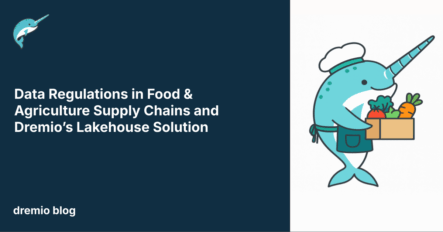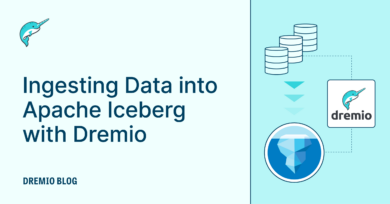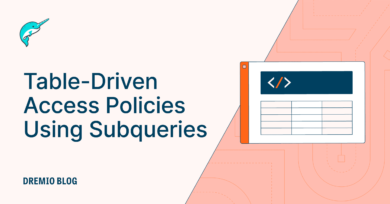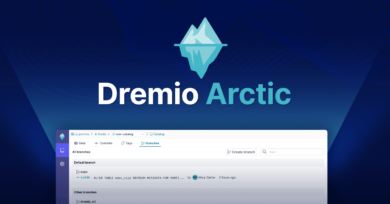18 minute read · September 24, 2025
Data Regulations in Food & Agriculture Supply Chains and Dremio’s Lakehouse Solution
· Head of DevRel, Dremio

From farm to fork, today’s food supply chains generate enormous volumes of data. Every shipment, every temperature check, every sustainability report leaves behind a digital trail, and regulators in both the EU and the U.S. now expect that trail to be complete, accurate, and instantly accessible.
Rules like the FDA’s Food Safety Modernization Act (FSMA) and the EU’s General Food Law demand end-to-end traceability of food products, while new frameworks such as the EU’s Corporate Sustainability Reporting Directive (CSRD) and Deforestation Regulation push companies to prove their environmental impact data is reliable. Add in growing due diligence requirements and consumer demand for transparency, and data teams in agriculture and food supply chains face a daunting task: managing diverse datasets at scale, ensuring governance, and delivering insights on demand.
Traditional data architectures, built on siloed systems and batch processing, struggle to keep up. What’s needed is a platform that can unify scattered supply chain data, guarantee lineage and governance, and deliver real-time analytics when regulators, or customers, come calling. This is where the Dremio Intelligent Lakehouse comes in.
In this post, we’ll explore the data challenges created by food and agriculture regulations in the EU and U.S., and show how Dremio’s lakehouse capabilities equip data engineers and architects to meet compliance demands while unlocking new value from supply chain data.
The Regulatory Landscape Driving Data Complexity
Food and agriculture supply chains don’t just move physical goods, they now also move vast amounts of data to satisfy regulators. In both the U.S. and EU, compliance requirements have expanded beyond traditional food safety checks to encompass traceability, sustainability, and full supply chain transparency. Each area introduces unique data management challenges that strain legacy systems.
Traceability and Food Safety
- U.S. Requirements: The FDA’s Food Safety Modernization Act (FSMA) Section 204 mandates rapid traceability for high-risk foods. Companies must capture Critical Tracking Events (like harvesting, shipping, and processing) and maintain Key Data Elements (like lot numbers and timestamps). Traceability records must be retrievable within 24 hours during an investigation.
- EU Requirements: The EU’s General Food Law (Regulation 178/2002) enforces “one step back, one step forward” traceability. Every operator must record both their immediate supplier and customer, creating a complete chain of accountability.
Data Challenge: These mandates demand granular, interconnected datasets that can be searched and joined quickly during recalls or audits. Traditional ETL-heavy platforms often struggle to provide this speed and transparency.
Try Dremio’s Interactive Demo
Explore this interactive demo and see how Dremio's Intelligent Lakehouse enables Agentic AI
Environmental and Sustainability Reporting
- EU Regulations: The Corporate Sustainability Reporting Directive (CSRD) requires food and agriculture companies to disclose Scope 3 emissions and supply chain environmental impact. The EU Deforestation Regulation (EUDR) adds a layer of geolocation reporting, requiring proof that commodities like coffee or soy are deforestation-free.
- U.S. Landscape: While less centralized, the SEC’s proposed climate disclosures and USDA/EPA requirements push companies toward similar transparency on emissions, water use, and land management.
Data Challenge: Sustainability data is often fragmented across IoT sensors, farm management systems, logistics providers, and corporate ERP. Aggregating and validating this data for regulators requires flexible ingestion and reliable lineage tracking.
Supply Chain Transparency and Due Diligence
- EU Developments: The Corporate Sustainability Due Diligence Directive (CS3D) compels firms to monitor environmental and human-rights risks deep into their supply chains. Non-compliance can result in financial penalties and reputational damage.
- U.S. Context: Federal rules are less prescriptive, but state-level laws and consumer pressure are forcing food companies to demonstrate supplier compliance and ethical sourcing.
Data Challenge: Supply chain transparency requires integrating data from external partners in varied formats while enforcing strict access controls. Data teams must balance openness with the need to protect sensitive supplier information.
Data Platform Requirements for Compliance
Meeting the regulatory demands in food and agriculture isn’t just about collecting more data, it’s about building a platform capable of handling the complexity, volume, and sensitivity of that data. For data engineers and architects, this means designing systems that go beyond traditional warehouses or siloed databases. The following capabilities are critical:
End-to-End Data Lineage and Traceability
Compliance isn’t just about the final number in a report; regulators increasingly want to know how you got there. A platform must track data lineage across ingestion, transformation, and consumption. Every compliance report, whether it’s a CO₂ emission figure or a product recall log, should be traceable back to the raw source data.
Real-Time Analytics and Rapid Data Retrieval
When an FDA inspector demands traceability records within 24 hours, or when an EU authority requests emissions data, waiting on overnight ETL jobs won’t cut it. Platforms need the ability to query fresh data directly from source systems or data lakes, ensuring timely responses to audits, recalls, or sustainability reviews.
Scalable Data Integration
Agriculture supply chains generate data from IoT sensors, ERP systems, cloud storage, third-party suppliers, and more. A compliance-ready platform must ingest and join this variety of structured, semi-structured, and unstructured data, without excessive manual pipelines that increase cost and complexity.
Governance and Security
Sensitive data like supplier contracts, personal information, or geolocation data requires strict control. Platforms need fine-grained access policies, data masking, encryption, and detailed audit logs to ensure compliance with both sector regulations and broader privacy laws like GDPR.
Cost-Efficient Scalability and Performance
Compliance data can stretch back years, creating massive historical datasets. Storing and analyzing these cost-effectively while maintaining interactive performance requires an architecture that separates storage from compute, scales elastically, and uses intelligent query acceleration.
Open and Interoperable Architecture
Regulations evolve, and so do the tools used to meet them. Locking compliance data into proprietary formats creates future risks. Open standards like Apache Iceberg and Arrow allow companies to integrate with emerging analytics, AI, and reporting tools while ensuring long-term accessibility of critical records.
Introducing Dremio’s Intelligent Lakehouse
The challenges created by modern food and agriculture regulations, lineage, integration, governance, and real-time performance, demand a new kind of data architecture. This is where the Dremio Intelligent Lakehouse comes in. Built on open standards like Apache Arrow and Apache Iceberg, Dremio combines the scalability of a data lake with the structure and speed of a data warehouse, while adding intelligent automation to reduce the manual burden on data teams.
What Makes It “Intelligent”
- Autonomous Optimization: Dremio continuously optimizes queries with features like Autonomous Reflections (always-fresh, automatically managed accelerations) and Iceberg Table Optimizations (compaction, clustering). This means performance stays high without constant tuning by engineers.
- Unified Semantic Layer: Dremio provides a single layer where business and technical users alike can discover, query, and reuse data. This semantic layer adds context, ensures consistent definitions, and eliminates duplicated effort.
- Open and Interoperable: Because it’s built on Iceberg and Arrow, Dremio’s lakehouse is fully interoperable with other engines and tools, ensuring compliance data isn’t locked into proprietary systems.
Bridging Compliance Needs and Technical Capabilities
Dremio’s features map directly to the requirements we laid out for food and agriculture compliance:
- Lineage and Traceability: Built-in lineage views show exactly how each dataset was derived, satisfying audit and traceability requirements.
- Real-Time Analytics: Queries run directly on fresh data in lakes, databases, or cloud storage, no ETL delays, making it easy to meet deadlines like the FDA’s 24-hour traceability rule.
- Data Integration at Scale: Virtualization allows federated queries across multiple systems, from IoT sensor logs to ERP systems, without heavy data movement.
- Governance and Security: Fine-grained access controls, row- and column-level security, and data masking protect sensitive information while enabling collaboration.
- Scalable and Cost-Efficient: Storage and compute separation, plus intelligent query acceleration, allow petabyte-scale compliance datasets to be managed without runaway costs.
- Future-Proof Architecture: Open standards ensure data remains usable across evolving regulatory frameworks and emerging compliance tools.
With these capabilities, Dremio doesn’t just help data engineers and architects survive compliance, it equips them to turn regulatory obligations into an opportunity for better data visibility, stronger supply chains, and even competitive advantage.
Solving Regulatory Challenges with Dremio – Key Capabilities
Regulations in the food and agriculture supply chain can feel overwhelming, traceability mandates, sustainability reports, and due diligence all demand different kinds of data handling. Dremio’s Intelligent Lakehouse provides a unified foundation where these diverse requirements can be addressed with precision. Let’s map the major regulatory challenges directly to Dremio’s technical strengths.
1. Data Lineage and Traceability
Challenge: Regulators require companies to prove where data came from, how it was transformed, and how it supports a compliance report.
Dremio’s Solution: Every dataset in Dremio is enriched with automatic lineage tracking. Data engineers can visualize the full journey of a dataset, from raw source through transformations to final analytics, creating a digital “traceability map.” This makes it straightforward to satisfy auditors or respond to requests under FSMA or EU General Food Law.
2. Governance and Security
Challenge: Compliance data often mixes highly sensitive information (personal data, supplier contracts, proprietary processes) with public reporting needs.
Dremio’s Solution: Fine-grained access controls, column- and row-level security, and masking features ensure only the right people see sensitive fields. Encryption and role-based policies keep data compliant with GDPR and other privacy laws while still usable for analytics.
3. Real-Time Analytics and Recall Readiness
Challenge: Regulations like FSMA 204 require companies to produce complete traceability records within 24 hours. Batch pipelines and siloed databases often can’t deliver this speed.
Dremio’s Solution: Dremio queries data in place, across multiple sources, with sub-second response times, no ETL delays. This allows teams to generate recall reports or sustainability summaries instantly, satisfying tight regulatory deadlines.
4. Unified Data Integration
Challenge: Data comes from IoT devices, ERP systems, logistics platforms, cloud storage, and supplier portals. Consolidating it is traditionally costly and complex.
Dremio’s Solution: Dremio’s data virtualization lets you query across all these sources with SQL, joining IoT logs, supplier spreadsheets, and corporate ERP data in a single view. Data engineers don’t need to build fragile, high-maintenance ETL pipelines just to answer compliance questions.
5. Scalability and Cost Efficiency
Challenge: Compliance requires keeping years of historical data, batch records, audit logs, environmental metrics, often at massive scale.
Dremio’s Solution: By separating storage and compute, and using intelligent query acceleration (like reflections and caching), Dremio keeps performance high without ballooning costs. This allows companies to store long-term compliance data in low-cost object storage while still analyzing it interactively.
6. Open and Future-Proof Architecture
Challenge: Regulations evolve, and proprietary platforms risk locking compliance data into rigid formats.
Dremio’s Solution: Built on Apache Iceberg and Apache Arrow, Dremio ensures data remains open, portable, and interoperable. Iceberg’s features like time travel and versioning also make it easy to reproduce historical reports for audits, showing exactly what data looked like on a given date.
Practical Scenario: A Recall Drill with Dremio
To see how these capabilities play out, imagine a food manufacturer facing a simulated recall drill. A supplier alerts them that a raw ingredient shipped last month may be contaminated. Regulators demand a full traceability report within 24 hours.
- Identifying Affected Batches
- The compliance team queries Dremio’s semantic layer to find all finished products that used the suspect ingredient.
- Dremio’s data virtualization lets them join procurement records in an ERP system with production logs in cloud storage, no ETL pipeline required.
- Within minutes, they have a list of affected batch numbers.
- The compliance team queries Dremio’s semantic layer to find all finished products that used the suspect ingredient.
- Tracing Distribution
- Using built-in lineage, the team follows those batches downstream into shipping and retail distribution data.
- They quickly map which warehouses, distribution centers, and retailers received the products, generating a comprehensive recall list.
- Using built-in lineage, the team follows those batches downstream into shipping and retail distribution data.
- Validating Safety of Other Products
- Parallel queries confirm that all other products tested within the same timeframe passed lab checks.
- Dremio’s ability to query fresh IoT and QC sensor data ensures even yesterday’s test results are included.
- Parallel queries confirm that all other products tested within the same timeframe passed lab checks.
- Producing an Audit-Ready Report
- With lineage views and dataset documentation, the team exports a report showing not just the recall list, but the proof of how it was derived.
- This satisfies the FDA’s requirement for an “electronic, sortable spreadsheet” of traceability data, delivered well under the 24-hour deadline.
- With lineage views and dataset documentation, the team exports a report showing not just the recall list, but the proof of how it was derived.
- Protecting Sensitive Data
- Role-based access controls ensure that only the recall task force can see supplier identities or batch-level details, while executives view a high-level status dashboard without sensitive fields.
- Role-based access controls ensure that only the recall task force can see supplier identities or batch-level details, while executives view a high-level status dashboard without sensitive fields.
The Result: Instead of scrambling through siloed systems and manual spreadsheets, the company uses Dremio to deliver a precise, auditable response. Regulators are satisfied, risk to consumers is minimized, and the business avoids unnecessary recalls of unaffected products.
Conclusion: Designing for Compliance and Beyond
Regulatory change in the food and agriculture supply chain is no longer about periodic paperwork, it’s about maintaining continuous, trustworthy, and accessible data. Whether it’s proving product lineage within 24 hours for the FDA, reporting Scope 3 emissions under the EU’s CSRD, or ensuring supplier compliance through due diligence laws, the common denominator is data complexity.
Traditional systems, fragmented databases, siloed spreadsheets, and batch-driven warehouses, simply can’t keep up with these demands. What’s needed is a platform that unifies data, guarantees lineage, enforces governance, and provides real-time analytics at scale.
This is where the Dremio Intelligent Lakehouse stands out. By combining open standards (Apache Iceberg, Arrow), autonomous performance optimizations, fine-grained governance, and a semantic layer, Dremio gives data engineers and architects the tools to turn regulatory obligations into a competitive advantage. With Dremio, compliance data isn’t just a burden to manage, it becomes a foundation for operational insights, supply chain resilience, and consumer trust.
The takeaway: regulations will only become stricter and more data-intensive. By adopting a lakehouse approach today, organizations can not only meet current compliance needs but also position themselves to thrive in a future where data transparency is a core expectation of doing business.


